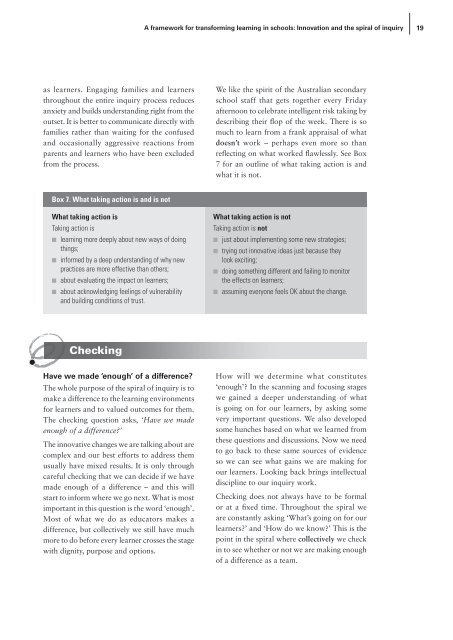Spiral of Inquiry
Spiral of Inquiry
Spiral of Inquiry
- No tags were found...
You also want an ePaper? Increase the reach of your titles
YUMPU automatically turns print PDFs into web optimized ePapers that Google loves.
A framework for transforming learning in schools: Innovation and the spiral <strong>of</strong> inquiry 19as learners. Engaging families and learnersthroughout the entire inquiry process reducesanxiety and builds understanding right from theoutset. It is better to communicate directly withfamilies rather than waiting for the confusedand occasionally aggressive reactions fromparents and learners who have been excludedfrom the process.We like the spirit <strong>of</strong> the Australian secondaryschool staff that gets together every Fridayafternoon to celebrate intelligent risk taking bydescribing their flop <strong>of</strong> the week. There is somuch to learn from a frank appraisal <strong>of</strong> whatdoesn’t work – perhaps even more so thanreflecting on what worked flawlessly. See Box7 for an outline <strong>of</strong> what taking action is andwhat it is not.Box 7. What taking action is and is notWhat taking action isTaking action is■■learning more deeply about new ways <strong>of</strong> doingthings;■■informed by a deep understanding <strong>of</strong> why newpractices are more effective than others;■■about evaluating the impact on learners;■■about acknowledging feelings <strong>of</strong> vulnerabilityand building conditions <strong>of</strong> trust.What taking action is notTaking action is not■■just about implementing some new strategies;■■trying out innovative ideas just because theylook exciting;■■doing something different and failing to monitorthe effects on learners;■■assuming everyone feels OK about the change.CheckingHave we made ‘enough’ <strong>of</strong> a difference?The whole purpose <strong>of</strong> the spiral <strong>of</strong> inquiry is tomake a difference to the learning environmentsfor learners and to valued outcomes for them.The checking question asks, ‘Have we madeenough <strong>of</strong> a difference?’The innovative changes we are talking about arecomplex and our best efforts to address themusually have mixed results. It is only throughcareful checking that we can decide if we havemade enough <strong>of</strong> a difference – and this willstart to inform where we go next. What is mostimportant in this question is the word ‘enough’.Most <strong>of</strong> what we do as educators makes adifference, but collectively we still have muchmore to do before every learner crosses the stagewith dignity, purpose and options.How will we determine what constitutes‘enough’? In the scanning and focusing stageswe gained a deeper understanding <strong>of</strong> whatis going on for our learners, by asking somevery important questions. We also developedsome hunches based on what we learned fromthese questions and discussions. Now we needto go back to these same sources <strong>of</strong> evidenceso we can see what gains we are making forour learners. Looking back brings intellectualdiscipline to our inquiry work.Checking does not always have to be formalor at a fixed time. Throughout the spiral weare constantly asking ‘What’s going on for ourlearners?’ and ‘How do we know?’ This is thepoint in the spiral where collectively we checkin to see whether or not we are making enough<strong>of</strong> a difference as a team.


